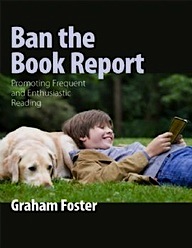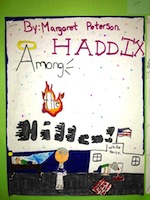Better Than Book Reports
Ban the Book Report: Promoting Frequent and Enthusiastic Reading
By Graham Foster
(Pembroke Publishers/Stenhouse, 2012 – Learn more)
Every year in September when I survey my students, more than 50 percent consider themselves non-readers. I embrace this challenge, and for the most part I would consider myself successful in turning that tide. After getting over their initial resistance to voluntarily reading a book, my next step is to monitor and support my students’ comprehension and make sure that they are actively engaging with the pages of the story.
For the past few years my students have mostly been required to respond to their independent reading in the form of a letter in their reading journals. Sometimes they write to the author, a character, or me. Other times, they write to a classmate. I believe this is an effective method to gaining insight to their comprehension, but maybe it is not the only effective way.
Graham Foster’s book, Ban the Book Report: Promoting Frequent and Enthusiastic Reading, offers creative alternatives to my letters and journals. Although I do not assign the traditional book reports I was required to produce in own reading past, I am always looking for more reading response options.
What’s inside the book

“Assignments have been designed for response to both fiction and nonfiction, and are planned to encourage personal response, including emotional response to text and the opportunity for students to consider items of personal interest. In addition, the assignments challenge close and thoughtful reading of text” (17).
The potential assignments cover the gamut of written and oral responses. Some suggested options include writing a diary entry for a character or a letter to the author, or presenting a talk-show interview. Here’s Foster describing one idea that caught my attention:
“Oral Reading of My Favorite Part of the Book benefits students who lack confidence in oral reading. Rather than stressful round-robin reading, this assignment allows student to prepare and practice their reading carefully before they present it to the class” (28).
Foster suggests that teachers who have assigned this particular activity two or three times a year have reported significant improvements. I think oral reading of favorite passages would be a good stretch for adolescent readers who fear nothing more than reading out loud.
There are also some suggestions in this book that I already use in my class, like writing a eulogy for a character. I foresee the material in Ban the Book Report: Promoting Frequent and Enthusiastic Reading as enhancing my existing eulogy assignment.
Student-friendly rubrics included
One aspect of the text that I would also like to highlight is that each assignment includes a student-friendly rubric. This element has the potential to increase student engagement and accountability. Another suggestion from the book that I will take forward is to not only give students the opportunity to assess their assignments but also to revise their own work.
The book also includes exemplars, an element that I found particularly useful. The exemplars are written about popular texts that many adolescent readers would find recognizable. So not only would the exemplars serve as models, but my students would be more intimately familiar with the content of the books themselves, which I think would further support their own reading responses. Some of the titles covered by exemplar texts are: Holes by Louis Sachar, The Son of Neptune by Rick Riordan, Touching Spirit Bear by Ben Mikaelsen, and Catching Fire by Suzanne Collins.
Foster devotes chapter 7 to responding to informational texts. With the advent of the Common Core Standards, many educators are searching for new and innovative ways to incorporate non-fiction and informational texts into their classrooms, and they will definitely find this chapter valuable.
NOTE: You can review the entire text of Ban the Book Report at the Stenhouse website.
An unusual final chapter
All told, the book includes 20 different possible assignments. In the book’s final chapter, Foster reveals that Ban the Book Report grew out of a year-long PD project in two middle schools and writes:
As a professional development activity, a group of teachers reviewed the 20 assignments presented in this book and chose the goal to develop parallel reading-response assignments–tasks that offered varied personally significant options, each with a rubric written in student-friendly language and each with illustrative exemplars. In a day, the group successfully developed eight assignments, each with a rubric. Teachers left the workshop with the intention of gathering exemplars for the eight assignments. (94)
Foster then provides the first part of the teachers’ work (assignments and rubrics, already laid out in reproducible grids) and invites teachers to complete each assignment by gathering their own exemplars from student work. He also includes tips about selecting student samples and respecting privacy.
The eight assignments include casting the characters in a movie of the film, social media, poetry, an author award, song connections, a scrapbook, a dramatic script, and a readers’ theatre.
Some final thoughts
One area where I think Foster’s book could provide further guidance is assessment. Teachers would be applying the same rubric that students use to assess themselves. What happens when there is a discrepancy between their self-assessment and ours? Would this undermine their efforts and make them feel that their assessment is “wrong”? How can we maintain high expectations and validate their voice during this process?
I think this book would interest teachers just beginning to explore independent reading as well as more experienced teachers who are looking for new ways to expand how their students respond to their reading.
Foster also includes a reading survey, which would be useful for literacy teachers who have not already developed their own. A reading survey offers a way to gain insight into who your students are as readers and would allow you to make better book recommendations for them as well.
Like most teachers, I love to get my hands on reproducibles that can be utilized as-is or can be modified. Foster’s pages are filled with such resources, and I look forward to using them with my readers!

After reading Ban the Book Report, Nicole Warchol put her new knowledge to work in her classroom (see image at right). You can see some of her students’ work products in this Dropbox folder.
Nicole Warchol is a 7th grade language arts teacher and a teacher consultant for the Kean University National Writing Project. She lives in New Jersey with Rocco, her six-year old Rottweiler-German Shepherd. She is a voracious reader, who occasionally writes poetry. Ms. Warchol can be found on Twitter @MsNWarchol and on her blog at www.thecraziestbooklady.wordpress.com.



































